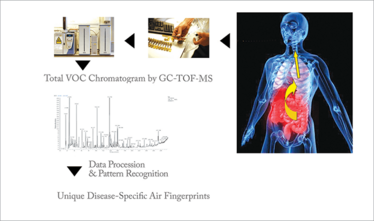
A Breath Test for the Bowel
A new panel of biomarkers present in exhaled breath may offer the first reliable, noninvasive way of diagnosing irritable bowel syndrome
At a Glance
- Although it’s a common and disruptive disorder, there’s currently no reliable way of testing for irritable bowel syndrome (IBS)
- Diagnosis often relies on invasive testing to exclude other diseases – but a new breath biomarker panel might offer a better way
- The panel measures 16 volatile organic compounds that appear in different quantities in the exhalations of IBS patients
- Eventually, it’s hoped that a point-of-care test for the condition could be developed that uses a small, simple electronic device to obtain and analyze the breath biomarker data
Irritable bowel syndrome (IBS) is currently somewhat of a mystery to the medical community. There’s no clear cause of the disorder, no reliable way of testing for it, and no cure. Patients are diagnosed based on tests to exclude other conditions, classified according to symptoms, and treated to alleviate the impact on their daily lives. But with a problem as common as IBS – believed to affect up to 15 percent of the population in developed countries (1) – the less guesswork involved in detecting and treating the condition, the better. That’s why we decided to focus on finding a quantitative biomarker to assist with IBS diagnosis. What we ended up with was a panel of 16 (2).
Why focus on IBS?
About 10 years ago, we were looking for possibilities to describe noninvasively inflammatory processes in the body. Our initial research suggested to us that measurement of chemicals in breath were promising for that purpose. In recent years, analyses of breath metabolites have shown potential as a method of identifying biomarkers for a range of disorders. Why is breath so interesting? It contains a surprising amount of information. There are numerous anecdotes about nurses and doctors who diagnose their patients’ problems by smell. Liver disease can show itself in bad breath due to sulfurous compounds; uncontrolled diabetics exhale acetone, giving their breath a sweet smell; even some dogs can spot cancer by smelling the patient’s breath (3).
What actually causes the odors that can lead to a diagnosis? These scents are combinations of specific volatile organic chemicals (VOCs) that activate a unique set of olfactory receptors in the brain. Human beings can detect up to 10,000 different scents – but which chemicals are related to which diseases? That’s the $64,000 question – and the reason we developed a biomarker discovery platform based on gas chromatography mass spectrometry (GC/MS). With that and a liberal application of multivariate statistics, we hope to find the chemicals associated with different diseases (see Figure 1).

Figure 1. The process of using exhaled VOCs as biomarkers for IBS and other disorders. Breath samples are captured in tubes and subjected to GC/MS; the resulting spectrum is analyzed to yield information on disease-specific alterations to concentrations of the relevant compounds.
IBS might not be the first condition that you would consider suitable for breath testing. Lungs are the obvious choice, but we soon realized that other internal organs release chemicals into the blood, and that those chemicals can enter the breath when the blood travels through the lungs. Recently, we showed that Crohn’s disease activity could be monitored by breath testing (4) – so we thought we would turn our attention to another bowel disease with an equally urgent medical need. IBS is a common functional gastrointestinal disorder for which no reliable biomarkers currently exist. Its diagnosis is based on subjective symptoms at the moment, but objective biomarkers could improve the process and reduce the psychological stress and potential health risks of invasive testing.
The pathophysiology of IBS is poorly understood – and so far, none of the markers that relate to the potential pathophysiological processes have proven to be reliable. The great advantage of analyzing VOCs is that every person’s breath contains a large number of these compounds. Many are products of metabolic or inflammatory processes in the human body – and some may result from the pathological processes of a specific disorder like IBS. Advanced statistical methods can identify small sets of compounds that are altered in patients relative to healthy control subjects. The beauty of this method is that we don’t need to know what causes the production of these metabolites; we just need to be able to measure them. So even without fully understanding the pathophysiology of IBS, we can measure all of the metabolites to discover biomarkers that are characteristic for the disorder, or for gut health in general.
Selecting specific markers
We found 16 VOCs – including butane, n-hexane, methylcyclohexane and aziridine – which together form the biomarker panel for IBS. Most of these compounds can’t be linked directly to a specific pathophysiological mechanism or metabolic process. The analysis of breath metabolites on this level is quite new, so we’re still working to determine the origin of many of the chemicals. One of the most interesting ones is aziridine, which is increased in breath of IBS patients compared to controls. It’s known to be produced by the Actinobacteria, one of the four predominant microbial phyla in the human body, so we can speculate that the aziridine we detect in breath may originate with these or similar gut bacteria. We also know from previous studies that the composition of the gut microbiota in IBS patients – including Actinobacteria – may be altered (5), so the changes to aziridine levels struck us as a finding worthy of further investigation.
To test our VOC biomarker panel as a whole, we asked subjects from a general population cohort to complete questionnaires on gastrointestinal symptoms. We selected 239 respondents with moderate to severe symptoms, regardless of whether or not they had an IBS diagnosis, and found it very interesting to see that the biomarker panel showed a moderate (r=0.54) – but highly significant – correlation with the severity of a range of gastrointestinal symptoms. This indicates that our biomarkers might be useful not only for patients with potential IBS or similar disorders, but even for studies that focus on gut health in the general population.
As in most scientific studies, every finding leads to new questions. From a scientific point of view, we’re very interested in identifying the biological processes from which the breath markers originate. We are working on that with cells in culture, mimicking individual pathological processes to see which compounds are released. From a clinical point of view, though, the next important step is the external validation of our biomarker panel in a second cohort of IBS patients. In particular, we want to test its potential to discriminate not only between IBS patients from healthy controls, but also between IBS and other disorders with similar clinical presentations.
Turning theory into reality
Eventually, we’d like to see the panel used for IBS diagnosis in the clinic. Of course, we’ll need more research before we reach that stage – but, if it continues to prove its potential throughout the next validation steps and in future studies, I can imagine an exciting future for it. For instance, at the moment, we trap the breath VOCs in tubes that are transported to the clinical chemistry department for GC/MS measurement and statistical analysis. That results in a diagnosis we can deliver to clinicians within hours. Our ultimate goal, though, is to develop a handheld device (like a miniaturized GC/MS or an electronic nose) that sits on the desk of the treating physician and exclusively detects the compounds included in our biomarker panel. The device would also have the ability to process the raw data, leading to an immediate diagnosis!
There’s plenty of potential for methods like these to reduce our current invasive diagnostics. One day, we hope they might replace tests like endoscopies, intestinal biopsies, and even blood draws. Right now, we’re still some way away from using our IBS breath test panel in day-to-day clinical work – but we’re optimistic that we’ll soon have that goal in our sights.
- S Maxion-Bergemann et al., “Costs of irritable bowel syndrome in the UK and US”, Pharmacoeconomics, 24, 21–37 (2006). PMID: 16445300.
- A Baranska et al., “Volatile organic compounds in breath as markers for irritable bowel syndrome: a metabolomics approach”, Aliment Pharmacol Ther, 44, 45–56 (2016). PMID: 27136066.
- M Schubert, “Animal Instincts”, The Pathologist, 19, 20–27 (2016). Available at: bit.ly/1TxrImq.
- AG Bodelier et al., “Volatile organic compounds in exhaled air as novel marker for disease activity in Crohn’s disease: a metabolomics approach”, Inflamm Bowel Dis, 21, 1776–1785 (2016). PMID: 26199990.
- X Zhuang et al., “Alterations of gut microbiota in patients with irritable bowel syndrome: a systematic review and meta-analysis”, J Gastroenterol Hepatol, [Epub ahead of print] (2016). PMID: 27300149.
Frederik-Jan van Schooten is Professor of Genetic and Molecular Toxicology in the Department of Pharmacology and Toxicology at Maastricht University, the Netherlands.
Zlatan Mujagic is an MD/PhD in the Division of Gastroenterology and Hepatology at Maastricht University Medical Center (MUMC+), the Netherlands.




















